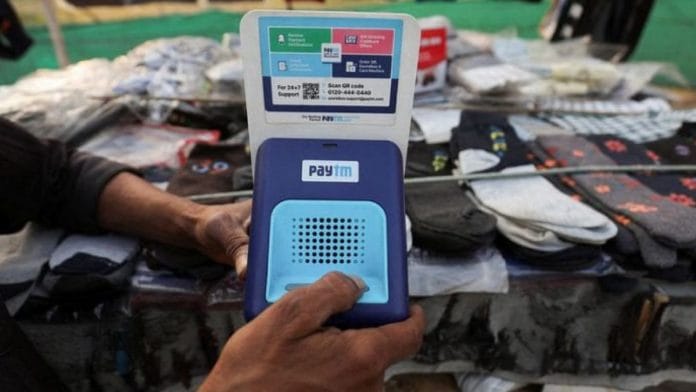At an industry event last week, Reserve Bank of India Governor Sanjay Malhotra raised questions about the viability of subsidising the Unified Payments Interface, or UPI — the backbone of India’s fast-payments ecosystem. This is a timely point, as a shift from subsidies to market-led models is becoming increasingly necessary.
Since its 2016 launch by the National Payments Corporation of India (NPCI), UPI has revolutionised digital payments in India through its seamless, app-based interface for instant transactions.
Unlike card networks such as Visa and Mastercard, which charge anywhere between 0.25 per cent and 3 per cent in transaction fees, UPI is largely free to use because the government subsidises its transactions. This gives UPI a competitive edge, undercutting rival systems that price their services to cover operational overheads, maintain infrastructure, and ensure security.
Also Read: India’s myopic view on tax policy hurts FDI. Fix it before it breaks the camel’s back
Subsidy masks real costs
Though UPI is free for users, the organisations that run it, including banks and payments services, bear substantial costs. These include expenses for processing and settling transactions, fraud prevention, server maintenance, redressing user complaints, and ensuring regulatory compliance. To keep all of this free for users, the government steps in with a subsidy. Over the past four years, it has spent more than Rs 7,500 crore subsidising access to UPI.
The UPI subsidy is first paid to the relevant merchant’s bank — for instance, the institution that receives payment when a user orders food on a delivery app. From there, it is shared among the other players in the UPI chain: the customer’s bank, the app facilitating the payment (such as PhonePe or Google Pay), and the bank running back-end UPI services.
But the scale of UPI far exceeds that of the subsidy. In FY 2023-24, the organisations running UPI reportedly spent over Rs 12,000 crore to keep the system operational — which is nearly four times the subsidy amount for that year. Designed for simplicity and scale, UPI has positioned India as a global leader in real-time payments. However, the NPCI’s continued reliance on public subsidy requires reconsideration.
Demonetisation in 2016 was an inflection point for digital payments, and UPI led the charge. India now leads the world in real-time payment volumes, recording 18,580 crore transactions in 2024-25.
But having enabled a paradigm shift in digital adoption and inclusion, UPI must now turn its focus toward enhancing quality and security.
Quality of service
Through March and April this year, UPI faced several outages, with banks reporting service disruptions caused by traffic overloads. Banking and payments services, which must absorb a large share of the costs to process an ever-growing volume of transactions— worth over Rs 261 lakh crore in FY24 — could not keep up with UPI’s scale. Spikes in user demand led to timeouts, failed payments, and unresponsive apps. Unlike in the case of card transactions, these entities have little incentive to expand server capacity, improve response time, or invest in fallback systems.
The NPCI is limiting transaction attempts in response to these outages. Among other measures, it proposes to cap the number of payment retries for subscription services such as insurance or entertainment apps. Subscribers will be able to make only three retries per transaction sequence, which may lead to unintentional service disruptions, missed deadlines, late-payment penalties, and increased manual effort. Such degradation in quality of service is antithetical to the logic of digital inclusion.
Cybersecurity and infrastructure resilience
Global payment networks such as Visa and Mastercard have invested heavily in fraud prevention and infrastructure security — roughly $10 billion and $7 billion, respectively — in the five years leading up to 2024. These costs are built into their business models and recovered through transaction fees. In contrast, UPI has no such mechanism to fund long-term upgrades, capacity building, or security infrastructure.
As the only fast-payment mode available in the country, UPI is also a potential single point of failure. During Operation Sindoor, government agencies flagged UPI infrastructure as a likely target for cyber threats. Global precedents highlight the risks associated with such exposure. The international financial-messaging network called SWIFT, through which most cross-border transactions flow, is a case that stands out. Seven Russian banks were removed from the system in 2022, forcing costly workarounds and exposing the fragility of concentrated payment systems.
Digital infrastructure is not just lines of code; it is also servers, cables, data centres, backup systems, and power supply. These components demand steady investment to keep systems running reliably and to remain secure from cyber threats.
Also Read: India’s TRP ecosystem needs a reset. Time to end BARC monopoly
Rethinking UPI
Based on last fiscal year’s UPI volumes, a hypothetical average fee of 50 paise per transaction would generate about Rs 9,000 crore in revenue. This amount is six times the latest subsidy allocated by the government. Therefore, graded and nominal, value-proportionate fees would create incentives for continuous improvements in quality of service and cybersecurity alike.
Analogously, Brazil’s Pix and China’s Alipay-WeChat Pay fast-payment ecosystems apply fees ranging from 0.2 to 0.6 per cent.
Governor Malhotra would also do well to reinitiate the RBI’s earlier attempts to create competition for the NPCI. There is no path available for potential competitors to spring up today, in the absence of enabling RBI guidelines.
Allowing free-market pricing and fostering competition through rival systems would give banks, payment services, and umbrella entities such as NPCI stronger incentives to improve quality and security continually. This would be a win for all concerned stakeholders — users, banks, payment systems, and regulators.
Vedika Pandey and Siva Bhargavi Nori are fintech specialists at Koan Advisory Group, New Delhi. Views are personal.
This article is part of ThePrint-Koan Advisory series that analyses emerging policies, laws and regulations in India’s technology sector. Read all the articles here.
(Edited by Asavari Singh)






